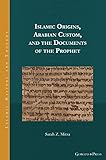Islamic Origins, Arabian Custom, and the Documents of the Prophet / Sarah Mirza.
Material type: TextSeries: Islamic History and Thought ; 17Publisher: Piscataway, NJ : Gorgias Press, [2022]Copyright date: ©2022Description: 1 online resource (335 p.)Content type:
TextSeries: Islamic History and Thought ; 17Publisher: Piscataway, NJ : Gorgias Press, [2022]Copyright date: ©2022Description: 1 online resource (335 p.)Content type: - 9781463206444
- 9781463239664
- 297.6/3092 23/eng/20220711
- BP75.9 .M579 2022
- online - DeGruyter
| Item type | Current library | Call number | URL | Status | Notes | Barcode | |
|---|---|---|---|---|---|---|---|
 eBook
eBook
|
Biblioteca "Angelicum" Pont. Univ. S.Tommaso d'Aquino Nuvola online | online - DeGruyter (Browse shelf(Opens below)) | Online access | Not for loan (Accesso limitato) | Accesso per gli utenti autorizzati / Access for authorized users | (dgr)9781463239664 |
Frontmatter -- TABLE OF CONTENTS -- Acknowledgments -- Abbreviations -- Introduction: Four ways of looking at the Prophet’s documents -- Chapter 1. Formulae -- Chapter 2. Variance -- Chapter 3. Infrastructure: Dhimma agreements, sanctuary systems, and a case for Arabian customary law -- Chapter 4. Persons: A popular material culture of ḥadīth -- Conclusion. There are no originals -- Appendix to Chapter 1: Comparative Arabic epistolary and legal formularies, from literary and documentary sources -- Appendix to Chapter 4: Correspondence between kitāba and istiʿmāl in biographical reports on Companions -- Bibliography -- Index
restricted access online access with authorization star
http://purl.org/coar/access_right/c_16ec
Along with the Qurʾān and ḥadīth, pragmatic documents negotiating land, taxes, and tribal relations are attributed to the Prophet Muḥammad (~570-632 CE) in early Islamic historiography. These are often viewed as relics reflecting the Prophet’s religio-political mission, or as anachronistic texts spuriously ascribed to him. Challenging both conclusions, this book argues that an indigenous Arabian legal and documentary tradition, distinct from classical Islamic law, can be traced in these documents. Laying out the formularies and formulae of around 200 such documents, these are compared to early Arabic papyri as well as older corpora including Aramaic conveyance documents, Sabaic letters, and Nabataean tomb inscriptions. The book also maps the variation found across medieval redactions of some of the documents; the case of one distinctive legal clause; and the tribal traditions of those who received the documents. The documents of the Prophet maintain a register of everyday transactions and customary law which survives compilation and redaction and is embedded in older local and transregional infrastructures which circulate the language, media, and forms for documents. These documents encourage a reconsideration of the concepts of authorship, literacy, and authenticity applied to medieval texts, as well as the presumed centrality of confessional identity in the legal infrastructures described by medieval Islamic genres such as sīra (biography), ḥadīth (traditions), and taʾrīkh (history). Rather than reflecting authorship as the creative acts of individuals, literacy as the decoding of written text, and authenticity as the faithful transmission of original texts over time, the documents of the Prophet are reflective of transregional communication technologies, customs that trace long-lived, geographically diffuse infrastructures of which formulae are the remnants.
Mode of access: Internet via World Wide Web.
In English.
Description based on online resource; title from PDF title page (publisher's Web site, viewed 29. Mai 2023)


